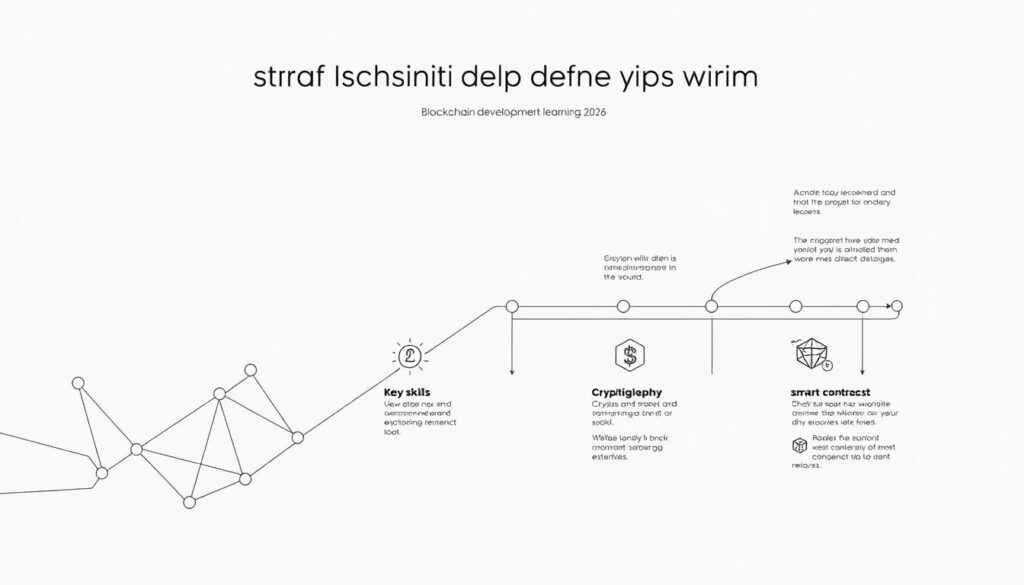Now Reading: Follow Blockchain Developer Roadmap 2026 Step by Step Learning Path
- 01
Follow Blockchain Developer Roadmap 2026 Step by Step Learning Path
Follow Blockchain Developer Roadmap 2026 Step by Step Learning Path

The world of technology is constantly evolving, creating exciting new career paths. One of the most promising fields today involves building the next generation of digital systems. This comprehensive guide is designed for aspiring professionals who want to enter this innovative field.
This career represents one of the most lucrative and future-focused technology positions available. Salaries average around $150,000 annually in the United States. It also offers fantastic opportunities to work remotely from anywhere.
A major advantage is accessibility. Unlike traditional tech roles, this path requires no formal college degree or computer science background. Success hinges on determination, a computer, and internet access.
This structured pathway outlines the complete journey from beginner to job-ready professional. It provides clear milestones and realistic timeframes based on actual student outcomes. The industry’s relative newness creates a significant advantage for early adopters.
This guide consolidates essential resources and best practices. It eliminates the frustration of outdated tutorials and fragmented learning materials. You can build valuable skills without wasting money on expensive bootcamps.
Key Takeaways
- This field offers high earning potential, with average U.S. salaries around $150,000.
- No formal degree is required, making the career accessible to dedicated individuals from diverse backgrounds.
- The timeline to become job-ready varies based on your weekly study commitment.
- Being an early adopter in this growing industry provides a competitive advantage.
- A structured approach prevents common pitfalls like “tutorial hell” and ensures measurable progress.
- Major companies are actively exploring ways to incorporate this technology into their operations.
Understanding the Blockchain Landscape
From its origins in digital currency, a powerful technology has expanded its reach into countless sectors. This shift represents a fundamental change in how we handle digital information.
Overview of Technology and Its Applications
Five years ago, most people only associated this innovation with cryptocurrencies. Today, its potential is recognized worldwide. The core appeal lies in its principles of decentralization, transparency, and built-in security.
These features provide new routes for digital transformation. Industries from supply chain management to healthcare records are exploring its use. The technology creates immutable records and establishes trust without central authorities.
Modern applications are incredibly diverse. They include decentralized finance platforms and systems for proving digital ownership. Enterprise solutions are also streamlining complex business processes.
| Aspect | Traditional Systems | Modern Distributed Systems |
|---|---|---|
| Control Structure | Centralized authority | Distributed network |
| Data Integrity | Trust-based verification | Cryptographically secured |
| Transaction Speed | Can be slowed by intermediaries | Peer-to-peer efficiency |
| Primary Use Cases | Standard databases, banking | dApps, smart contracts, DeFi |
Why It Is a Game-Changer in Modern Tech
The game-changing nature of this technology stems from its architecture. It moves away from centralized control toward distributed networks. Transparency and security are built into the core design.
Decentralized applications demonstrate this transformative potential. They enable direct peer-to-peer interactions. This reduces costs and increases transaction speeds significantly.
Organizations recognize it as a strategic investment. Major corporations and governments are allocating resources to explore solutions. This creates unprecedented demand for skilled professionals who understand distributed systems.
Laying the Foundation with Computer Science and Cryptography
A solid technical foundation is the cornerstone of any successful career in building distributed systems. This groundwork consists of two critical pillars: core computer science principles and cryptographic security. Mastering these areas provides the mental framework needed to understand how modern networks function at their most basic level.
Essential Computer Science Concepts
Strong programming knowledge begins with computer science fundamentals. Key concepts include data structures like arrays and hash tables. These structures determine how information is organized and retrieved efficiently.
Database management is another vital area. It teaches how to structure data and maintain its integrity. This knowledge translates directly to designing applications for decentralized storage environments.

Understanding algorithmic complexity helps optimize performance. This affects decisions on transaction processing and resource management. It ensures applications run smoothly and cost-effectively.
Cryptography Fundamentals
Cryptography forms the security backbone of this technology. It involves techniques for secure communication in the presence of adversaries. Public-key cryptography, for example, enables secure transactions and digital identities.
Hash functions create unique, immutable identifiers for data blocks. Digital signatures verify authenticity without exposing sensitive keys. Grasping these concepts is essential for implementing robust security.
| Computer Science Area | Core Concept | Direct Application |
|---|---|---|
| Data Structures | Arrays, Linked Lists, Trees | Organizing transaction data in blocks |
| Algorithms | Complexity Analysis | Optimizing smart contract execution |
| Cryptography | Public-Key Encryption | Creating secure wallet addresses |
| Database Systems | Data Integrity | Maintaining consistent ledger state |
Courses like Harvard’s CS50 offer excellent starting points. They provide a structured introduction to these essential computer science topics. Building this foundational knowledge prepares you for more advanced specialized study.
Grasping the Essentials of Smart Contracts and Decentralized Applications
Self-executing code stored on distributed networks is revolutionizing how digital agreements are formed and enforced. These automated contracts represent a core component of modern distributed systems.
How Smart Contracts Power Blockchain Solutions
Smart contracts are programmable agreements that execute automatically when conditions are met. They eliminate intermediaries and reduce transaction costs significantly.
Understanding the lifecycle of these contracts is crucial for any blockchain developer. This includes development, testing, deployment, and execution phases.

Security considerations dominate smart contract development. Deployed contracts are immutable and often control significant value.
| Aspect | Traditional Contracts | Smart Contracts |
|---|---|---|
| Execution | Manual enforcement | Automatic execution |
| Intermediaries | Required for trust | Eliminated |
| Cost | Higher transaction fees | Reduced costs |
| Transparency | Limited visibility | Fully transparent |
Building Decentralized Applications: Use Cases and Benefits
Decentralized applications combine smart contract backend logic with user-friendly interfaces. They operate without central servers or controlling authorities.
The use cases for these applications span diverse industries. This includes financial services, gaming platforms, and supply chain systems.
Learning Solidity, the primary programming language for Ethereum contracts, is essential. Resources like CryptoZombies offer gamified approaches to master this development skill.
Building tangible portfolio projects demonstrates both technical competency and understanding of real-world applications. This distinguishes professional developers from tutorial followers.
blockchain developer roadmap 2026 step by step learning path
A well-structured educational pathway transforms beginners into skilled professionals in the Web3 space. This systematic approach ensures comprehensive skill development without overwhelming learners.

Step-by-Step Guide from Basics to Advanced Concepts
The progression begins with computer science fundamentals. Data structures and database management form the essential technical foundation.
Next comes understanding distributed ledger principles. This includes consensus mechanisms and cryptographic security features.
Practical experience with major platforms like Ethereum provides real-world context. Hands-on work builds confidence and technical competence.
Choosing quality training accelerates the learning process. Structured courses offer guided progression through complex topics.
Certification validates expertise to potential employers. Recognized credentials demonstrate professional commitment.
Community participation offers networking and support. Engaging with peers provides valuable insights and feedback.
Portfolio development showcases practical abilities. Building actual applications demonstrates real-world readiness.
The complete educational journey typically spans 4-6 months with dedicated effort. Prior programming experience can reduce this timeframe significantly.
Choosing the Right Blockchain Training and Certification Courses
Selecting appropriate educational resources is a critical decision that can significantly impact your career trajectory in this field. The market offers diverse options from free tutorials to comprehensive certification programs.

Each learning path serves different needs and budgets. Understanding these differences helps you make informed choices about your education.
Comparing Free Courses, Bootcamps, and Certification Paths
Free resources like Cyfrin Updraft provide exceptional value with 96+ hours of content. These platforms make quality education accessible without financial barriers.
Structured bootcamps offer guided progression through complex topics. They combine video tutorials with hands-on exercises for practical skill development.
Certification programs validate your expertise to potential employers. Credentials like the Certified Enterprise Blockchain Professional demonstrate professional commitment.
The best approach often combines multiple resources. Free courses build foundational knowledge while certifications provide formal validation.
Consider your learning style and career goals when choosing. Self-directed learners may thrive with free resources, while others benefit from structured programs.
Developing Hands-On Skills Through Real-World Projects
Practical experience separates aspiring professionals from true experts in this innovative field. Theoretical knowledge becomes truly valuable when applied to actual development challenges.
Platforms like Speed Run Ethereum provide structured challenges for building seven distinct web3 applications. These projects progressively increase complexity while teaching essential skills.
Project-Based Learning: Building and Testing dApps
Creating decentralized applications forces developers to confront real implementation challenges. This process builds problem-solving abilities that tutorials cannot fully simulate.
Gamified experiences like CryptoZombies make learning engaging through incremental achievements. They help master syntax and common patterns in an memorable format.
Security considerations must be integrated throughout project development. Using established libraries and thorough testing ensures robust applications.
Building diverse projects demonstrates multifaceted capabilities to employers. A strong portfolio showcases both technical proficiency and understanding of user experience.
The skills developed extend beyond coding to include project planning and documentation. These competencies are essential for professional team environments.
Embracing an Adaptable Mindset for Continuous Learning
Technical skills open doors, but mental flexibility keeps them open throughout your career. The distributed systems landscape evolves at an extraordinary pace. New protocols and tools emerge constantly.
Professionals who embrace change rather than resist it position themselves for long-term success. This field’s relative immaturity means even experts encounter unfamiliar challenges regularly. Asking questions and learning from mistakes become normalized behaviors.
Cultivating versatility across multiple platforms and programming languages is crucial. Specializing too narrowly risks obsolescence as the industry matures. The patience to experiment with different approaches distinguishes true professionals.
| Fixed Mindset Approach | Adaptable Mindset Approach | Long-Term Impact |
|---|---|---|
| Resists new tools and methods | Experiments with emerging technologies | Remains relevant as industry evolves |
| Specializes in single platform | Develops cross-platform versatility | Adapts to shifting market demands |
| Views mistakes as failures | Treats errors as learning opportunities | Builds resilience and problem-solving skills |
Continuous learning habits ensure your knowledge remains current. Reading technical documentation and participating in hackathons provides practical experience. Contributing to open-source projects demonstrates commitment to growth.
This adaptable approach extends to career planning itself. Recognizing that roles and required skills will shift over time prepares you for industry maturation. The ability to rebuild solutions based on user feedback creates lasting value.
Leveraging Developer Communities and Networking Opportunities
Online communities have transformed how aspiring technologists learn and grow. They provide immediate access to collective wisdom and support.
Learning complex skills alone can be frustrating and slow. Communities like ZTM Discord and Cyfrin Updraft create supportive environments.
Benefits of Joining Online Communities and Discord Channels
These platforms connect you with peers and experienced professionals. You can ask questions and get feedback on projects.
Cyfrin Updraft’s community has over 14,000 developers and auditors. This creates massive networking potential.
Collaborating on real-world projects builds valuable experience. You learn industry workflows and gain portfolio pieces.
Learning from Experienced Developers and Mentors
Mentors provide shortcuts around common mistakes. They share insider knowledge about tools and practices.
This guidance helps newer professionals make strategic career decisions. It accelerates the learning process significantly.
Community participation also develops communication skills. These are essential for professional technical roles.
Integrating Web3 Frontend Development Skills with Blockchain
The user interface serves as the critical connection point between complex smart contract functionality and everyday users. Without intuitive frontend design, even the most powerful decentralized applications remain inaccessible.
Essential tools bridge this gap effectively. Ethers.js provides comprehensive functionality for Ethereum interaction. Wagmi offers React hooks for common operations. Viem delivers modular TypeScript-first APIs. The Alchemy SDK enhances these capabilities with advanced features.
| Tool | Primary Focus | Key Advantage | Best For |
|---|---|---|---|
| Ethers.js | Complete Ethereum interaction | Industry standard library | General purpose development |
| Wagmi | React-based dApps | Pre-built hooks | Rapid prototyping |
| Viem | TypeScript development | Modular architecture | Performance optimization |
| Alchemy SDK | Enhanced API access | Automated retries | Production applications |
Integrating these tools requires understanding wallet connections and transaction management. Developers must handle gas estimation and network configurations gracefully. Real-time updates ensure smooth user experiences despite network latency.
Mastering both frontend and backend development creates full-stack capabilities. This comprehensive skill set enables independent project development. It also opens broader career opportunities in the evolving technology landscape.
Staying Updated with Industry Trends and Trusted News Sources
Industry knowledge extends far beyond technical skills to include understanding market dynamics and regulatory changes. Professionals who track these developments position themselves for long-term success in this rapidly evolving field.
Following Major Blockchain News Outlets
Trusted publications like Coindesk and Cointelegraph provide daily insights into protocol upgrades and project launches. These resources help distinguish legitimate technological advances from temporary hype cycles.
Regular consumption of industry news creates awareness of security vulnerabilities and common attack patterns. This knowledge informs defensive programming practices and risk assessment capabilities.
Understanding regulatory landscapes and institutional adoption patterns provides crucial context for career decisions. This broader perspective helps identify emerging opportunities before they become mainstream requirements.
Engaging with technical blogs and research papers offers deeper insights into why certain technological directions are pursued. This understanding enhances professional conversations and networking effectiveness.
Staying current with trends allows professionals to anticipate skill demand shifts. This proactive approach ensures continued relevance in a competitive job market.
Conclusion
Success in this rapidly evolving field hinges on following a structured approach that balances technical mastery with practical application. The comprehensive guidance provided here offers a clear route to professional competency.
This career path delivers exceptional opportunities with competitive compensation and remote work flexibility. The journey typically spans several months of dedicated study, accessible to anyone with determination and internet access.
Mastering both technical abilities and soft skills ensures long-term growth. Building a strong portfolio through hands-on projects demonstrates real-world readiness to potential employers.
The industry’s continuous expansion creates favorable conditions for skilled professionals. Embracing this transformative technology field promises intellectual challenge and meaningful contribution to digital innovation.
FAQ
What programming languages are most important for a career in this field?
Solidity is the primary language for creating smart contracts on platforms like Ethereum. Knowledge of JavaScript or Python is also highly valuable for building decentralized applications and interacting with various systems.
How long does it typically take to gain the necessary skills?
The time required varies based on your prior experience. With a background in computer science, you might build foundational knowledge in several months. Achieving professional proficiency often takes a year or more of dedicated learning and project work.
Are certifications important for becoming a blockchain developer?
While a strong portfolio of real-world projects is often more critical, certifications from reputable sources can validate your skills and enhance your resume, especially for those new to the industry.
What are the key security concepts I need to understand?
A deep understanding of cryptography is essential, including hashing and public-key encryption. You must also learn to write secure smart contracts to prevent vulnerabilities and protect decentralized applications.
Can I learn blockchain development without a degree in computer science?
Yes, many successful professionals are self-taught. A strong grasp of core programming concepts, data structures, and security principles is crucial, which can be acquired through online courses and hands-on practice.
What kind of projects should I build to gain practical experience?
Start with simple smart contracts, then progress to full-stack dApps. Building a token, a decentralized exchange, or a voting system are excellent projects that demonstrate a wide range of skills to potential employers.















